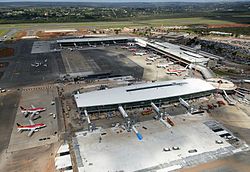Brasília Airport
| Aeroporto Internacional de Brasília - Presidente Juscelino Kubitschek |
|
|---|---|

|
|
| Characteristics | |
| ICAO code | SBBR |
| IATA code | BSB |
| Coordinates | |
| Height above MSL | 1060 m (3478 ft ) |
| Transport links | |
| Distance from the city center | 12 km south of Brasília |
| Street | DF-002 / DF-025 |
| Local transport | bus |
| Basic data | |
| opening | May 3, 1957 |
| operator | Inframérica |
| Terminals | 2 |
| Passengers | 17,855,163 (2018) |
| Air freight | 54,081 t (2018) |
| Flight movements |
153,796 (2018) |
| Capacity ( PAX per year) |
21 million |
| Runways | |
| 11R / 29L | 3300 m × 45 m asphalt |
| 11L / 29R | 3200 m × 45 m asphalt |
| website | |
| https://www.bsb.aero | |
The Brasília airport , official name Aeroporto Internacional de Brasília - Presidente Juscelino Kubitschek , is the international airport of the Brazilian capital Brasília . The airport, named after the former Brazilian President Juscelino Kubitschek , houses over 130 shops and four theaters and is one of the most modern airports in the country. In the 2000s, the number of passenger handling increased to over seventeen million in 2017. This made it the third largest in Brazil this year in terms of passenger numbers after the two airports São Paulo-Guarulhos and São Paulo-Congonhas . It is the hub of LATAM Airlines Brasil .
history
Building history
Even before the city of Brasília was founded, there was an airport called Vera Cruz, which was commissioned in 1955 by the governor of Goiás Bernardo Sayão. At that time it consisted of only one sand runway, 2700 meters long. A year later, President Juscelino Kubitschek landed to get an idea of the area that was earmarked for the capital city.
With the completion of the Catetinho , the official residence of the President, construction work began on the new airport in neighboring Lago Sul on November 6, 1956. On April 2, 1957, the President's plane landed on the completed runway. An official opening took place on May 3rd. In the same year, the facilities of the Brazilian Air Force , which work with the airport, opened.
At the beginning of the 1990s, the airport was given its present form with a central structure and two separate wings for departure and arrival. In the first construction phase, a bridge was inaugurated in 1992, which enables passengers to access the terminals. In a second section, the main wing was renovated in 1994 and nine passenger boarding bridges were added. A second runway was set up in 2006 as a result of the increasing number of passengers.
Traffic figures

| year | Passenger volume | Air freight ( tons ) (with airmail) |
Flight movements |
|---|---|---|---|
| 2018 | 17,855,163 | 54,081 | 153,796 |
| 2017 | 16,912,680 | 49,042 | 148,619 |
| 2016 | 17,947,153 | 36.093 | 161.167 |
| 2015 | 19,821,796 | 39,480 | 186.377 |
| 2014 | 18.146.405 | 40,795 | 183,874 |
| 2013 | 16,489,987 | 43,623 | 179,656 |
| 2012 | 15,891,530 | - | - |
| 2011 | 15,398,737 | - | - |
| 2010 | 14,347,061 | - | - |
| 2009 | 12,213,825 | - | - |
| 2008 | 10,443,393 | - | - |
| 2007 | 11,119,872 | - | - |
| 2006 | 9,699,911 | - | - |
| 2005 | 9,426,569 | - | - |
| 2004 | 9,926,786 | - | - |
| 2003 | 6,840,843 | - | - |
Airlines
Brasília Airport is served by the following companies:
Incidents
- On May 25, 1982 a VASP Boeing 737-200 (PP-SMY) touched down with the nose landing gear first during landing at Brasília Airport in rainy weather. The nose landing gear broke, causing the machine to come off the runway and the fuselage to break apart. Of the 118 people on board, two passengers were killed.
See also
Web links
- Official website (English, Portuguese, Spanish)
- Airport data on World Aero Data ( 2006 )
- Airport data in the Aviation Safety Network (English)
Individual evidence
- ^ A b The Airport - Data and Information. BSB.aero, accessed on June 15, 2018 .
- ↑ a b c d e The Airport - Statistics. BSB.aero, accessed April 9, 2019 .
- ↑ Airport Guide - Airlines Companies. BSB.aero, accessed February 2, 2019 .
- ^ Accident report B-737-200 PP-SMY , Aviation Safety Network (English), accessed on February 23, 2019.